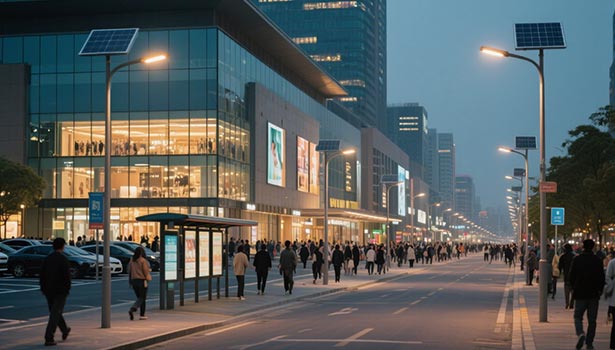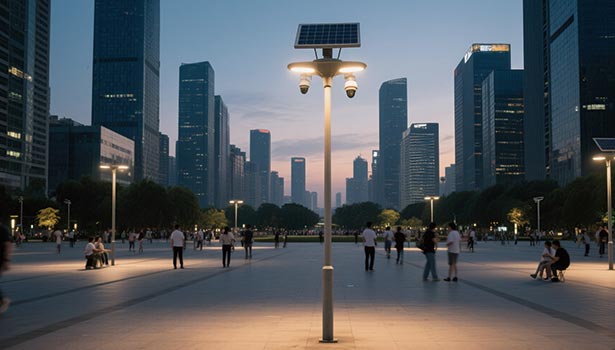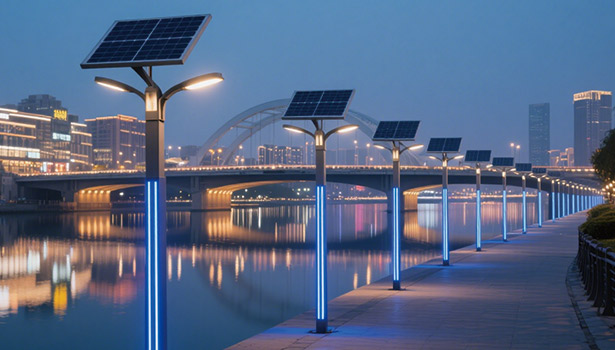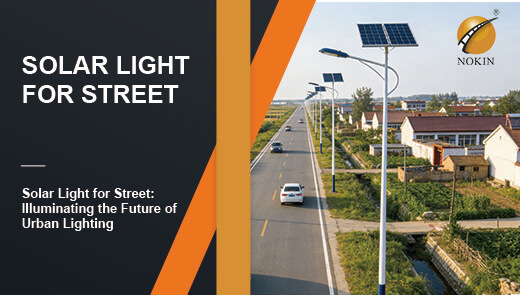How to Choose Commercial Street Lights for Your Project?
Whether it's a commercial district, large parking lot, or sports venue, commercial street lights play a key role as “nighttime guardians” — they not only ensure the safe passage of pedestrians and vehicles, but also balance energy costs, fit in with the project's aesthetics, and even comply with local environmental regulations. However, choosing the wrong street lights can be costly: insufficient brightness can lead to safety hazards, excessive energy consumption can increase long-term expenses, and non-compliant designs may result in project rework. This article will guide you step-by-step from needs assessment to product comparison, helping you select commercial street lights that are suitable for your project and ensuring that every decision is both scientific and practical.

Evaluating the Need for Commercial Street Lights
Traffic Flow Determines Brightness Standards
High-traffic areas such as downtown commercial streets and major urban thoroughfares, where pedestrian and vehicle density is high, should use 8,000–12,000 lumens to handle complex road conditions and prevent safety incidents like collisions or falls caused by poor visibility. In low-traffic areas with fewer pedestrians and vehicles, brightness can be appropriately reduced to meet basic lighting needs while minimizing energy waste and electricity costs.
Adjusting Lighting Based on Surrounding Amenities
If the area covered by street lights is near commercial or recreational facilities such as shopping malls, restaurants, or parks, the lighting intensity in the “entrance area” should be prioritized. Bright lighting can attract foot traffic, enhance user experience, and indirectly support commercial operations. If the area is near residential zones, the angle and color temperature of the light should be controlled, with a preference for 3000K warm white light, to avoid direct glare on residents' windows, prevent nighttime disturbances, and ensure the quality of residents' rest.
Select Durable Attributes Based on Environmental Conditions
Differences in outdoor environments directly impact the lifespan of street lights, so selection must be tailored to specific conditions: In coastal areas heavily affected by sea breeze salt content, prioritize aluminum alloy lamp bodies; in regions with frequent rainfall or snowfall, ensure an IP65 or higher waterproof rating to prevent internal circuit short-circuits; In typhoon-prone areas with strong winds, high-strength lamp posts made of Q235 steel should be used to ensure wind load resistance, preventing lamp posts from toppling or being damaged during extreme weather, thereby reducing post-installation maintenance costs and project delay risks.
Consider Local Regulations for Street Lights
Local regulations for commercial street lights vary by region. Failure to comply may result in project suspension, fines, or even demolition and reconstruction. Before finalizing a design, verify the following four categories of regulations: For pole height, commercial districts require 8–12 meters, main roads 12–15 meters, and parking lots 6–8 meters to ensure uniform lighting without obstructing traffic signs; Brightness and power: 8,000–12,000 lumens and ≤150W for main roads, 5,000–8,000 lumens and ≤100W for commercial side streets, with anti-glare and adequate brightness; color temperature is typically required to be ≤4,000K to reduce blue light pollution.
Factors to Consider When Choosing Commercial Street Lights
Energy Efficiency
Energy efficiency acts as the “hidden cost controller” for commercial street lights. High-efficiency products can significantly reduce long-term energy consumption costs. Under the same brightness levels, LED street lights consume far less power than traditional types. For example, an 8,000-lumen output requires approximately 100W for LED street lights, compared to 150W for HPS street lights and 140W for metal halide lamps. Additionally, LED lifespan exceeds 50,000 hours, which is 2-3 times longer than HPS and 3-5 times longer than metal halide lamps, resulting in longer replacement cycles and reduced maintenance. Although the initial procurement cost of LED lights is 30%-50% higher than traditional street lights, the electricity cost savings from low energy consumption can quickly offset the initial investment.

Light Output
Many people fall into the trap of thinking that “the brighter, the better” when choosing street lights. However, the ‘uniformity’ of lighting is more critical than brightness. If the area directly below the street light is bright while the space between two lights is dark, it creates a “visual blind spot,” increasing safety risks for pedestrians and vehicles. When selecting street lights, two key parameters should be prioritized: first, the lumen output, which must be precisely matched to the specific environment. For example, parking lots should use 3,000–5,000 lumens, while main roads should use 8,000–12,000 lumens. This avoids wasting energy with excessively high lumen output or impairing visibility with insufficient brightness.
Second, the beam angle. Prioritize a wide beam angle of 120°-180°, as this type of beam covers a broader area, effectively reducing the dark zone between two lights, ensuring uniform lighting across the entire area, and enhancing nighttime traffic safety, especially suitable for densely populated commercial districts with heavy pedestrian and vehicle traffic.
Durability and Reliability
Commercial street lights are exposed to outdoor conditions year-round, enduring wind, sunlight, and rain. The material and protection rating directly determine their lifespan and maintenance frequency. For material selection, the lamp body should prioritize aluminum alloy, which offers excellent corrosion resistance and can withstand humid or coastal environments; the lampshade should use tempered glass, which has strong impact resistance and is less prone to damage from hail or branch impacts; and lamp posts are made of Q235 steel, balancing strength and cost-effectiveness to meet wind load requirements in most regions.
The protection rating should be at least IP65 to withstand daily rainfall and dust accumulation; in rainy regions, upgrading to IP66 is recommended to prevent internal circuit short-circuits caused by heavy rain; coastal regions also require manufacturers to apply a “salt fog-resistant coating” to prevent salt corrosion from sea winds, extending the service life of the lamp body and poles.
Design and Aesthetics
Street lights combine functionality with decorative appeal, and their design should align with the project's style. For historic and cultural districts, retro-style lamps mimicking gas lamps, made of cast aluminum, are recommended, paired with 3000K warm white light to evoke a nostalgic atmosphere; For modern commercial centers, sleek, integrated LED street lights with 4000K neutral white light are recommended to highlight a tech-forward aesthetic; For parks or scenic areas, landscape-style street lights with decorative patterns and low-brightness warm light are recommended, providing adequate illumination while avoiding the disruption of natural nights capes caused by harsh light.
Maintenance and Serviceability
After installation, maintenance costs and difficulties for commercial street lights are often overlooked. Frequent maintenance not only increases additional expenses but may also disrupt project operations, such as causing traffic congestion during road construction or repairs. When selecting street lights, prioritize component disassembly ease to ensure lamp covers and power modules can be removed with simple tools, enabling part replacements without specialized equipment to reduce operational complexity. Additionally, prioritize suppliers with robust after-sales support, preferably those offering over one year of warranty coverage and local service centers, to ensure on-site repairs within 48 hours of a fault occurrence, preventing delays caused by slow after-sales response that could impact project usability.
Different Types of Commercial Street Lights
Light-Emitting Diode (LED) Street Lights
LED street lights offer outstanding energy efficiency, consuming significantly less energy than other types of street lights while providing the same brightness. They also have a long lifespan of over 50,000 hours (approximately 5 years), requiring minimal maintenance during their operational period. Additionally, their uniform light output effectively eliminates “visual blind spots,” ensuring safe nighttime traffic.

However, the obvious drawback of LED street lights is their relatively high initial procurement cost, which is 30%-50% higher than traditional high-pressure sodium lamps. In terms of applicability, they are suitable for almost all commercial projects, whether in commercial districts, large parking lots, or urban main roads, meeting requirements for lighting, energy efficiency, and safety. Specific prices may vary depending on brand, power, and functionality.
High-Pressure Sodium (HPS) Street Lights
As a representative of traditional street lights, the core advantage of high-pressure sodium lamps lies in their low initial procurement costs, while also emitting warm light to create a comfortable, nostalgic nighttime ambiance, making them suitable for scenarios with specific lighting ambiance requirements. However, their drawbacks are also significant: they have high energy consumption, with power consumption approximately 50% higher than LED street lights when achieving the same brightness level; they have a short lifespan of 15,000–20,000 hours (approximately 2 years), requiring frequent bulb replacements and resulting in high maintenance costs. Additionally, their luminous efficacy is low, and their light distribution uniformity is far inferior to that of LED street lights.
Metal Halide Street Lights
The core advantage of metal halide lamps is their high brightness and ability to emit clear white light, making them stand out in scenarios requiring high-intensity lighting, providing a bright and clear visual environment for the area. However, its drawbacks are also evident: high energy consumption, though slightly lower than high-pressure sodium lamps, it remains significantly higher than LED street lights; slow startup time, requiring 5–10 minutes to reach full brightness upon activation, failing to meet the demand for “instant lighting”; and a short lifespan of 10,000–15,000 hours (approximately 1.5 years), resulting in high maintenance frequency and costs.
Making More Precise Choices for Commercial Street Lights
Street Light Lifecycle Costs
Many purchasers tend to focus solely on initial procurement costs while neglecting long-term expenses. In reality, lifecycle costs are the core metric for evaluating cost-effectiveness, encompassing all expenses over the 5-10 year lifespan of a street light, including procurement, electricity bills, and maintenance. Taking a single street light as an example, the lifecycle costs of an LED street light include procurement costs, long-term electricity bills, and minimal maintenance expenses.
While high-pressure sodium lamps have lower procurement costs, their long-term electricity costs and maintenance expenses are significantly higher, making them less economical overall compared to LED street lights. Calculating the total lifecycle cost helps avoid “sacrificing the bigger picture for small gains,” enabling more scientifically informed procurement decisions from a long-term perspective, particularly suitable for commercial projects with extended operational cycles.
Enhance Energy Efficiency with Smart Control Features
If the project budget allows, it is recommended to choose street lights with smart features. These street lights can further reduce energy consumption, minimize maintenance costs, and improve management efficiency through technological means. Common smart features include motion sensing and remote control. Motion sensing enables “dimming on demand,” automatically reducing brightness from 100% to 30% when no people or vehicles are present. Actual case studies have shown this can save 30%-50% in electricity costs; remote control allows real-time monitoring of each street light's operational status via an app, such as brightness and fault information. In case of a fault, the system automatically alerts, eliminating the need for manual inspections and significantly reducing labor costs, making it particularly suitable for large-scale projects.
Choose Reliable Suppliers to Avoid Counterfeit Products
The selection of suppliers directly impacts the quality of street lights and subsequent services. Therefore, it is essential to prioritize manufacturers with the necessary qualifications and avoid counterfeit products. It is advisable to conduct on-site inspections to assess performance in real-world scenarios. Select manufacturers offering over one year of warranty coverage and local service centers, while requiring them to commit to on-site repairs within 48 hours to prevent operational disruptions due to delayed after-sales support.
When selecting commercial street lights, avoid blindly following trends. Start by clearly defining scene requirements and adhering to local regulations, focusing on energy efficiency, durability, and life cycle costs. Pair these with compatible smart features and reliable suppliers to ensure street lights maintain safety standards while balancing energy efficiency and aesthetics, truly becoming long-term beneficiaries of the project as “nighttime guardians.”




